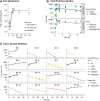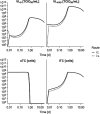Mechanistic Modeling of a Novel Oncolytic Virus, V937, to Describe Viral Kinetic and Dynamic Processes Following Intratumoral and Intravenous Administration
- PMID: 34366859
- PMCID: PMC8343024
- DOI: 10.3389/fphar.2021.705443
Mechanistic Modeling of a Novel Oncolytic Virus, V937, to Describe Viral Kinetic and Dynamic Processes Following Intratumoral and Intravenous Administration
Abstract
V937 is an investigational novel oncolytic non-genetically modified Kuykendall strain of Coxsackievirus A21 which is in clinical development for the treatment of advanced solid tumor malignancies. V937 infects and lyses tumor cells expressing the intercellular adhesion molecule I (ICAM-I) receptor. We integrated in vitro and in vivo data from six different preclinical studies to build a mechanistic model that allowed a quantitative analysis of the biological processes of V937 viral kinetics and dynamics, viral distribution to tumor, and anti-tumor response elicited by V937 in human xenograft models in immunodeficient mice following intratumoral and intravenous administration. Estimates of viral infection and replication which were calculated from in vitro experiments were successfully used to describe the tumor response in vivo under various experimental conditions. Despite the predicted high clearance rate of V937 in systemic circulation (t1/2 = 4.3 min), high viral replication was observed in immunodeficient mice which resulted in tumor shrinkage with both intratumoral and intravenous administration. The described framework represents a step towards the quantitative characterization of viral distribution, replication, and oncolytic effect of a novel oncolytic virus following intratumoral and intravenous administrations in the absence of an immune response. This model may further be expanded to integrate the role of the immune system on viral and tumor dynamics to support the clinical development of oncolytic viruses.
Keywords: mechanistic modeling; oncolytic virus; tumor distribution; viral dynamics; viral kinetics.
Copyright © 2021 Parra-Guillen, Freshwater, Cao, Mayawala, Zalba, Garrido, de Alwis and Troconiz.
Conflict of interest statement
Authors TF, YC, KM, and DA were employed by the company Merck & Co, Inc, Kenilworth, United States. The remaining authors declare that the research was conducted in the absence of any commercial or financial relationships that could be construed as a potential conflict of interest.
Figures






Similar articles
-
Oncolytic virus V937 in combination with PD-1 blockade therapy to target immunologically quiescent liver and colorectal cancer.Mol Ther Oncol. 2024 Apr 24;32(2):200807. doi: 10.1016/j.omton.2024.200807. eCollection 2024 Jun 20. Mol Ther Oncol. 2024. PMID: 38745749 Free PMC article.
-
Assessment of Clinical Response to V937 Oncolytic Virus After Intravenous or Intratumoral Administration Using Physiologically-Based Modeling.Clin Pharmacol Ther. 2023 Sep;114(3):623-632. doi: 10.1002/cpt.2937. Epub 2023 Jun 2. Clin Pharmacol Ther. 2023. PMID: 37170933
-
Phase 1, open-label, dose-escalation study on the safety, pharmacokinetics, and preliminary efficacy of intravenous Coxsackievirus A21 (V937), with or without pembrolizumab, in patients with advanced solid tumors.J Immunother Cancer. 2023 Jan;11(1):e005007. doi: 10.1136/jitc-2022-005007. J Immunother Cancer. 2023. PMID: 36669791 Free PMC article. Clinical Trial.
-
Treatment of malignant melanoma with coxsackievirus A21 (V937): An emerging oncolytic virotherapy.Exp Dermatol. 2024 Sep;33(9):e15169. doi: 10.1111/exd.15169. Exp Dermatol. 2024. PMID: 39207089 Review.
-
Intratumoral Immunotherapy-Update 2019.Oncologist. 2020 Mar;25(3):e423-e438. doi: 10.1634/theoncologist.2019-0438. Epub 2019 Nov 29. Oncologist. 2020. PMID: 32162802 Free PMC article. Review.
Cited by
-
Mathematical Modeling of Oncolytic Virus Therapy Reveals Role of the Immune Response.Viruses. 2023 Aug 25;15(9):1812. doi: 10.3390/v15091812. Viruses. 2023. PMID: 37766219 Free PMC article.
-
Nonclinical pharmacokinetics and biodistribution of VSV-GP using methods to decouple input drug disposition and viral replication.Mol Ther Methods Clin Dev. 2022 Dec 28;28:190-207. doi: 10.1016/j.omtm.2022.12.013. eCollection 2023 Mar 9. Mol Ther Methods Clin Dev. 2022. PMID: 36700123 Free PMC article.
-
A physiologically based pharmacokinetic model for V937 oncolytic virus in mice.Front Pharmacol. 2023 Sep 13;14:1211452. doi: 10.3389/fphar.2023.1211452. eCollection 2023. Front Pharmacol. 2023. PMID: 37771727 Free PMC article.
-
Prospective approaches to gene therapy computational modeling - spotlight on viral gene therapy.J Pharmacokinet Pharmacodyn. 2024 Oct;51(5):399-416. doi: 10.1007/s10928-023-09889-1. Epub 2023 Oct 17. J Pharmacokinet Pharmacodyn. 2024. PMID: 37848637 Free PMC article. Review.
-
Editorial: Model-informed decision making in the preclinical stages of pharmaceutical research and development.Front Pharmacol. 2023 Apr 12;14:1184914. doi: 10.3389/fphar.2023.1184914. eCollection 2023. Front Pharmacol. 2023. PMID: 37124233 Free PMC article. No abstract available.
References
-
- Al-Tuwairqi S. M., Al-Johani N. O., Simbawa E. A. (2020). Modeling Dynamics of Cancer Virotherapy with Immune Response. Adv. Differ. Equ 2020. 10.1186/s13662-020-02893-6 - DOI
LinkOut - more resources
Full Text Sources

